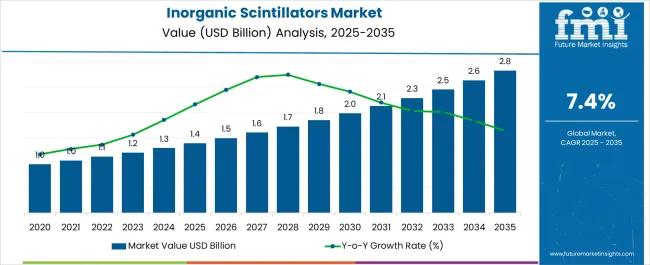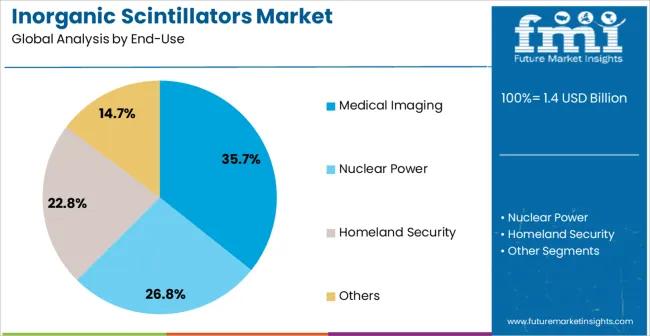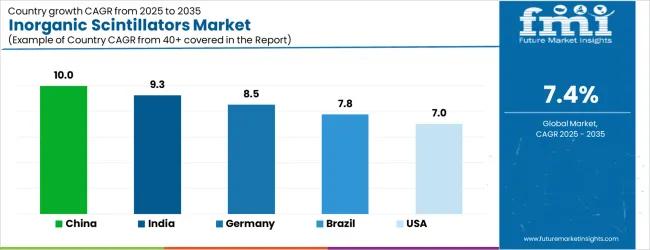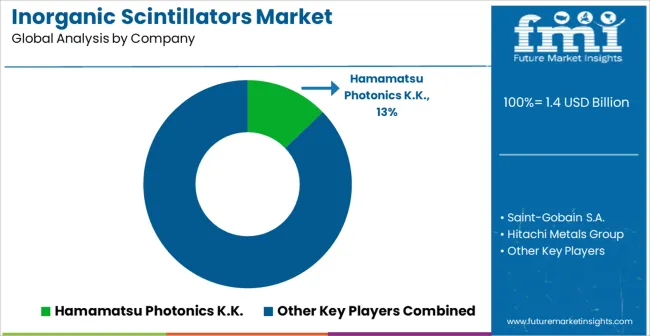The Inorganic Scintillators Market is estimated to be valued at USD 1.4 billion in 2025 and is projected to reach USD 2.8 billion by 2035, registering a compound annual growth rate (CAGR) of 7.4% over the forecast period.

| Metric | Value |
|---|---|
| Inorganic Scintillators Market Estimated Value in (2025 E) | USD 1.4 billion |
| Inorganic Scintillators Market Forecast Value in (2035 F) | USD 2.8 billion |
| Forecast CAGR (2025 to 2035) | 7.4% |
The Inorganic Scintillators market is experiencing steady growth, driven by the increasing demand for high-performance detection systems in medical, industrial, and scientific applications. Rising adoption in healthcare imaging, particularly in diagnostic procedures such as computed tomography, positron emission tomography, and gamma imaging, is creating strong demand for inorganic scintillator materials with high resolution, efficiency, and reliability. Advancements in crystal growth techniques, material purity, and performance optimization are enhancing detection sensitivity and energy resolution, supporting broader adoption across end-use industries.
The market is also being shaped by increasing investments in advanced healthcare infrastructure, medical research, and diagnostic capabilities in both developed and emerging economies. Regulatory focus on patient safety and the need for precise imaging in disease detection further support market expansion.
As technological innovations continue to improve light output, decay time, and stability, inorganic scintillators are becoming the preferred choice for high-performance detection applications Growing awareness of early disease diagnosis and ongoing adoption of advanced imaging modalities are expected to sustain long-term market growth.
The inorganic scintillators market is segmented by end-use, and geographic regions. By end-use, inorganic scintillators market is divided into Medical Imaging, Nuclear Power, Homeland Security, and Others. Regionally, the inorganic scintillators industry is classified into North America, Latin America, Western Europe, Eastern Europe, Balkan & Baltic Countries, Russia & Belarus, Central Asia, East Asia, South Asia & Pacific, and the Middle East & Africa.

The medical imaging segment is projected to hold 35.7% of the Inorganic Scintillators market revenue in 2025, establishing it as the leading end-use industry. Growth in this segment is being driven by the increasing need for precise and reliable diagnostic imaging technologies in hospitals, diagnostic centers, and research institutions. Inorganic scintillators provide high energy resolution, fast response times, and excellent detection efficiency, which are essential for accurate imaging and early disease detection.
The integration of these materials into computed tomography, positron emission tomography, and gamma cameras enhances imaging clarity and reduces patient exposure to radiation. Investments in advanced healthcare infrastructure, rising prevalence of chronic and lifestyle diseases, and increasing demand for early diagnosis are further propelling adoption.
Additionally, research advancements aimed at improving scintillator performance, including enhanced crystal purity and optimized light yield, are strengthening the segment’s position As hospitals and imaging centers increasingly prioritize high-precision diagnostics, the medical imaging segment is expected to remain the dominant driver of market growth, supported by technological innovation and healthcare expansion.
Inorganic scintillators are crystals that exhibit property of luminescence when excited by radiation. Inorganic scintillators are manufactured at high temperatures using alkali halides and oxides. Inorganic scintillators have high stability in presence of intense ionizing radiations are employed primarily for detection of radiation. On the basis of its end use, inorganic scintillators can be bifurcated in to four major application segments namely nuclear power plants, homeland security, defense and other high energy physics applications.
Inorganic scintillators market can be bifurcated into four major product segments including sodium iodide, gadolinium oxysulfide, and cesium iodide and other niche segments. Growing number of high energy physics applications are fuelling the research and development activities in the inorganic scintillators market.
The surge in research and development activities has led to increase in the number of product segments in the market. Bismuth germanate, lead tungstate among others are some of the niche product segments of inorganic scintillators. The product segments are directly employed in pure form or are mixed with elements such as thallium as per the end use. Sodium iodide is the most dominant product segment in terms of market share and the trend is expected to continue in the near future.
Inorganic scintillators can be customized to detect small amount of radiation and also have high stability when exposed to high amount of radiation. Depending on the end use, inorganic scintillators can be customized and their production can be controlled. High degree of customization and high efficiency of these scintillators have been major factors driving demand for inorganic scintillators.
Increasing research and development activities leading to a surge in the application scope of these scintillators also has been driving inorganic scintillators market growth. Increasing defense and homeland security budgets by nearly all major economies across the globe is expected to drive the market during the forecast period.
However increasing demand for renewable energy sources such as solar, wind and geothermal energy as a substitute for nuclear energy has been a major factor restraining growth for the demand of inorganic scintillators.
North America dominates the global demand for inorganic scintillators in terms of market share and the trend is expected to continue during the forecast period. Europe is the second largest consumer for inorganic scintillators. However, North America and Western Europe are among the foremost regions driving the demand of renewable energy sources such as solar.
Increasing number of occupational health hazards incidents such as cancer in nuclear plants are among other major factors restraining growth for inorganic scintillators in North America and Europe. Therefore, inorganic scintillators market is anticipated to grow at a sluggish rate during the forecast period in Western Europe and North America.
Asia Pacific is the third largest consumer for inorganic scintillators. Increase in demand for energy is foremost driving factors for inorganic scintillators in the Asia Pacific region. India and China are among the fastest growing economies in terms of economic development primarily driven by increasing industrial investment and huge population in the region.
Increasing demand for energy in these developing regions has been the foremost driver for the demand for inorganic scintillators in Asia Pacific. High security concerns in Asia Pacific between neighboring nations including India, China and Pakistan leading to increase in defense and homeland security budgets are among other drivers for the demand of inorganic scintillators in Asia Pacific.
Raw material procurement and innovation are critical success factors in inorganic scintillators market and the industry is characterized by high degree of competition. Some of the major players in the inorganic scintillators market Toshiba Corporation, Mirion Technologies, Inc., Saint-Gobain SA and Hitachi Metals America Ltd. among others.
The research report presents a comprehensive assessment of the market and contains thoughtful insights, facts, historical data, and statistically supported and industry-validated market data. It also contains projections using a suitable set of assumptions and methodologies. The research report provides analysis and information according to market segments such as geographies, application, and industry.

| Country | CAGR |
|---|---|
| China | 10.0% |
| India | 9.3% |
| Germany | 8.5% |
| Brazil | 7.8% |
| USA | 7.0% |
| UK | 6.3% |
| Japan | 5.6% |
The Inorganic Scintillators Market is expected to register a CAGR of 7.4% during the forecast period, exhibiting varied country level momentum. China leads with the highest CAGR of 10.0%, followed by India at 9.3%. Developed markets such as Germany, France, and the UK continue to expand steadily, while the USA is likely to grow at consistent rates. Japan posts the lowest CAGR at 5.6%, yet still underscores a broadly positive trajectory for the global Inorganic Scintillators Market. In 2024, Germany held a dominant revenue in the Western Europe market and is expected to grow with a CAGR of 8.5%. The USA Inorganic Scintillators Market is estimated to be valued at USD 515.3 million in 2025 and is anticipated to reach a valuation of USD 515.3 million by 2035. Sales are projected to rise at a CAGR of 0.0% over the forecast period between 2025 and 2035. While Japan and South Korea markets are estimated to be valued at USD 74.0 million and USD 44.2 million respectively in 2025.

| Item | Value |
|---|---|
| Quantitative Units | USD 1.4 Billion |
| End-Use | Medical Imaging, Nuclear Power, Homeland Security, and Others |
| Regions Covered | North America, Europe, Asia-Pacific, Latin America, Middle East & Africa |
| Country Covered | United States, Canada, Germany, France, United Kingdom, China, Japan, India, Brazil, South Africa |
| Key Companies Profiled | Hamamatsu Photonics K.K., Saint-Gobain S.A., Hitachi Metals Group, Dynasil Corporation of America, Toshiba Materials Co., Ltd., Rexon Components, Inc., Shanghai Siccas High Technology Corporation, EPIC Crystal Co., Ltd., Alpha Spectra, Inc, Nihon Kessho Kogaku Co., Ltd., Detec, Scintaco, and Amcrys |
The global inorganic scintillators market is estimated to be valued at USD 1.4 billion in 2025.
The market size for the inorganic scintillators market is projected to reach USD 2.8 billion by 2035.
The inorganic scintillators market is expected to grow at a 7.4% CAGR between 2025 and 2035.
The key product types in inorganic scintillators market are medical imaging, nuclear power, homeland security and others.
In terms of , segment to command 0.0% share in the inorganic scintillators market in 2025.






Our Research Products

The "Full Research Suite" delivers actionable market intel, deep dives on markets or technologies, so clients act faster, cut risk, and unlock growth.

The Leaderboard benchmarks and ranks top vendors, classifying them as Established Leaders, Leading Challengers, or Disruptors & Challengers.

Locates where complements amplify value and substitutes erode it, forecasting net impact by horizon

We deliver granular, decision-grade intel: market sizing, 5-year forecasts, pricing, adoption, usage, revenue, and operational KPIs—plus competitor tracking, regulation, and value chains—across 60 countries broadly.

Spot the shifts before they hit your P&L. We track inflection points, adoption curves, pricing moves, and ecosystem plays to show where demand is heading, why it is changing, and what to do next across high-growth markets and disruptive tech

Real-time reads of user behavior. We track shifting priorities, perceptions of today’s and next-gen services, and provider experience, then pace how fast tech moves from trial to adoption, blending buyer, consumer, and channel inputs with social signals (#WhySwitch, #UX).

Partner with our analyst team to build a custom report designed around your business priorities. From analysing market trends to assessing competitors or crafting bespoke datasets, we tailor insights to your needs.
Supplier Intelligence
Discovery & Profiling
Capacity & Footprint
Performance & Risk
Compliance & Governance
Commercial Readiness
Who Supplies Whom
Scorecards & Shortlists
Playbooks & Docs
Category Intelligence
Definition & Scope
Demand & Use Cases
Cost Drivers
Market Structure
Supply Chain Map
Trade & Policy
Operating Norms
Deliverables
Buyer Intelligence
Account Basics
Spend & Scope
Procurement Model
Vendor Requirements
Terms & Policies
Entry Strategy
Pain Points & Triggers
Outputs
Pricing Analysis
Benchmarks
Trends
Should-Cost
Indexation
Landed Cost
Commercial Terms
Deliverables
Brand Analysis
Positioning & Value Prop
Share & Presence
Customer Evidence
Go-to-Market
Digital & Reputation
Compliance & Trust
KPIs & Gaps
Outputs
Full Research Suite comprises of:
Market outlook & trends analysis
Interviews & case studies
Strategic recommendations
Vendor profiles & capabilities analysis
5-year forecasts
8 regions and 60+ country-level data splits
Market segment data splits
12 months of continuous data updates
DELIVERED AS:
PDF EXCEL ONLINE
Industry Share Analysis for Inorganic Scintillators Companies
Inorganic Cobalt Blue Pigments Market Size and Share Forecast Outlook 2025 to 2035
Inorganic filler Market Size and Share Forecast Outlook 2025 to 2035
Inorganic Oxides Market Size and Share Forecast Outlook 2025 to 2035
Inorganic Salts Market Size and Share Forecast Outlook 2025 to 2035
Inorganic Zinc Coatings Market Size and Share Forecast Outlook 2025 to 2035
Inorganic Fungicide Market - Growth & Demand 2025 to 2035
Inorganic Flame Retardants Market
Inorganic Ion Exchange Materials Market
White Inorganic Pigment Market Size and Share Forecast Outlook 2025 to 2035
Scintillators Market Size and Share Forecast Outlook 2025 to 2035

Thank you!
You will receive an email from our Business Development Manager. Please be sure to check your SPAM/JUNK folder too.
Chat With
MaRIA